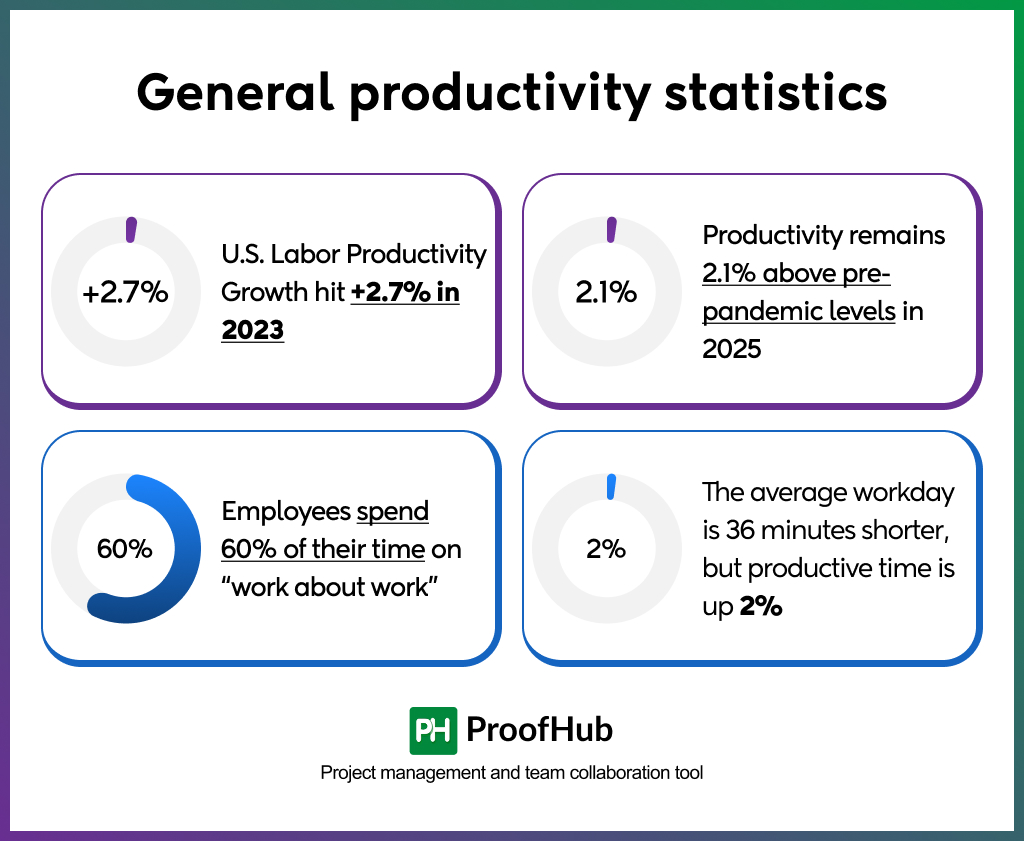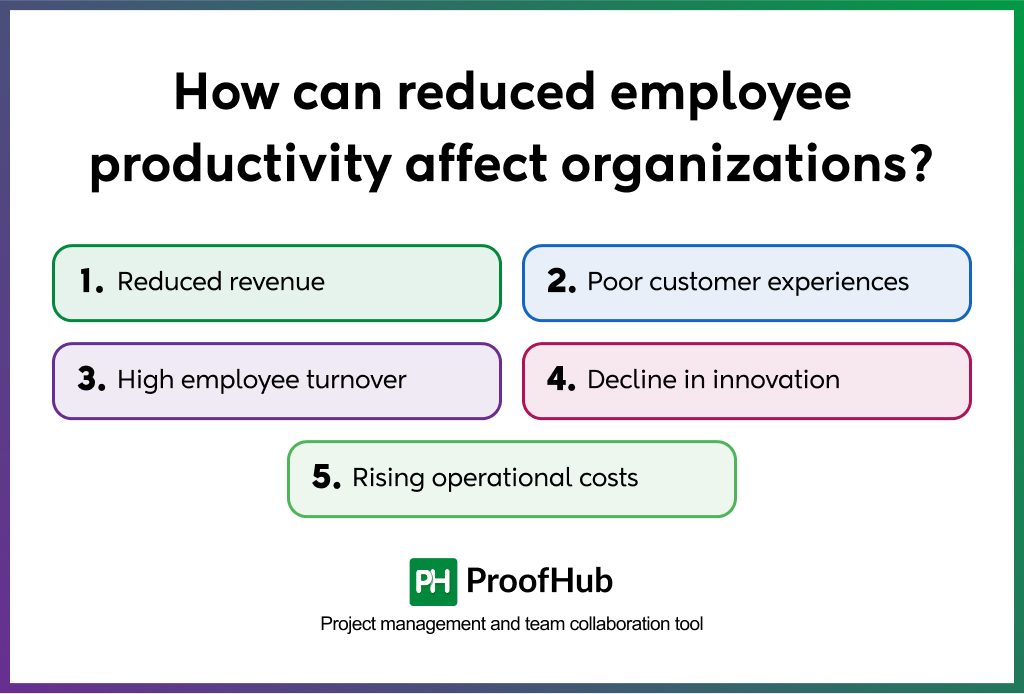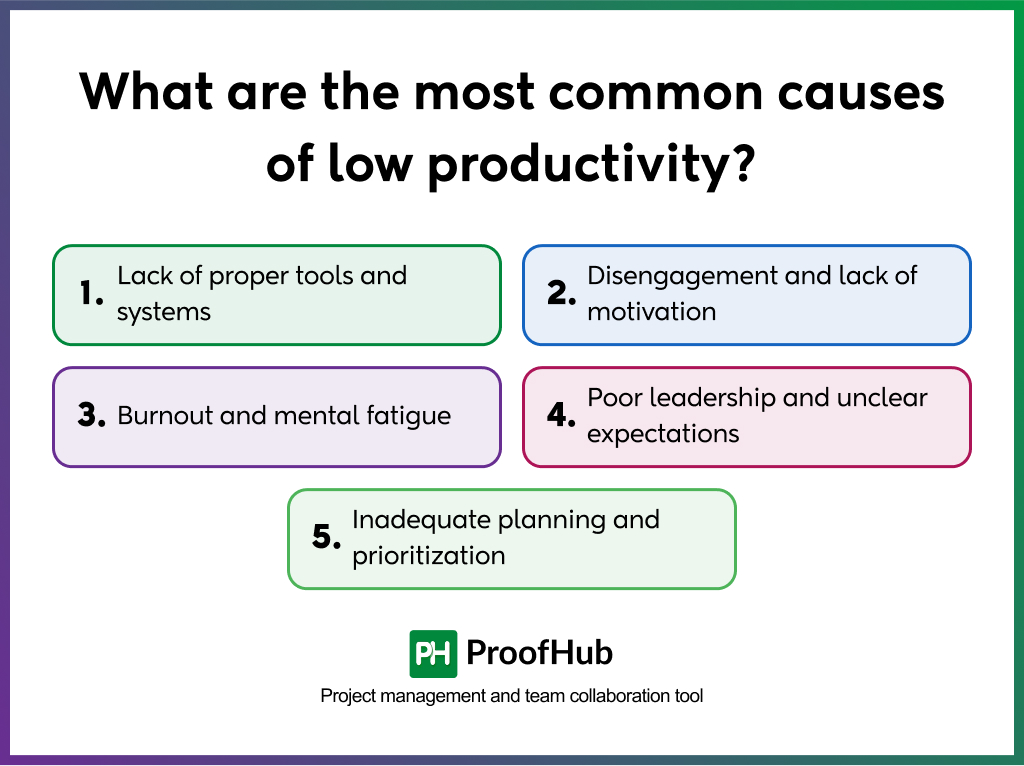Did you know that employees are productive for only 2 hours and 53 minutes in an average 8-hour workday?
That single stat says a lot. It’s not only about how long we work, it’s more about how we work. Workplace productivity statistics reflect how teams perform and reveal why some succeed while others lag behind.
As a manager, you already know that productivity is about focus, engagement, mental health, tools that define how work is done, not merely about time spent. But separating ideas from reality is practically difficult without data.
Over the past few years, the workplace has evolved – remote work, AI integration, and always changing employee expectations have redefined what productivity looks like. This article compiles 34 workplace productivity statistics and trends that will help you understand and optimize performance.
Backed by reliable sources like the U.S. Bureau of Labor Statistics, Gallup, McKinsey, and enterprise reports, these stats will provide you a clear, fact-based perspective of what is influencing performance in 2026.
34 Key workplace productivity statistics
To understand the statistics effectively, we have arranged 34 research-backed productivity statistics into thematic categories.
Each set provides valuable insights into different workplace dimensions from general productivity trends and the effects of remote work to the role of mental health, technology, and team collaboration.
Key takeaways from the stats:
- Identify inefficiencies, track trends like remote work, and spot issues such as burnout.
- Get clear insights into where time is lost and how team performance compares to industry standards.
- Make smarter decisions to boost efficiency and employee well-being.
General productivity statistics

- U.S. Labor Productivity Growth hit +2.7% in 2023
This is the highest increase in 20 years, showing that employees are producing more output in less time. It reflects how organizations are adopting smarter work practices such as automation, better project management tools, and more agile workflows. This emphasizes the need to invest in technology and efficiency-focused processes.
- Productivity remains 2.1% above pre-pandemic levels in 2025
Even with a change in how and where we work, overall productivity has not dropped; it’s improved. This ongoing improvement proves that hybrid and remote models, along with digital collaboration tools, are long-term productivity enhancers. Businesses that continue to support flexibility and digital transformation are likely to stay ahead.
- Employees spend 60% of their time on “work about work”
A significant portion of the workday is lost to non-core tasks such as switching between apps, attending unnecessary meetings, or tracking down information. This stat highlights a massive productivity drain. For leaders, it’s a wake-up call to reduce digital clutter, streamline workflows, and adopt centralized tools that help their teams focus on getting actual work done.
- The average workday is 36 minutes shorter, but productive time is up 2%
Despite working less time each day, employees are achieving more. This proves that efficiency doesn’t rely on long working hours; it requires thoughtful planning, fewer distractions, and tools that streamline work. For teams, it’s a sign that results matter more than time spent at the desk.
Remote work and hybrid statistics
- 66% of companies say remote work increased productivity
When teams work remotely, they often manage their time better, face fewer office distractions, and work more efficiently. If two-thirds of companies are seeing improved performance, it’s clear that remote work can boost productivity when implemented with the right tools.
- Remote workers are 9% more productive than in-office peers
This productivity edge comes from fewer interruptions, more focus, and a workspace customized to personal preferences. Even a 9% gain can significantly impact deadlines, project outcomes, and team performance, especially when scaled across an entire organization.
- Remote-only employees gain 29 minutes of productive time daily
That adds up to over 120 extra productive hours per year per employee, just by eliminating commutes. Employees can use this extra time for strategic work, creative thinking, or cross-team collaboration. It’s an advantage that directly affects business agility.
- 60% of employees want hybrid work
Employee expectations have changed significantly. Companies that offer remote flexibility attract top talent, improve job satisfaction, and retain valuable team members. Ignoring this demand could mean losing out to competitors that prioritize workplace flexibility.
- Employers save $11,000 per remote worker annually
These savings come from reduced office space, lower utility bills, fewer supplies, and decreased travel reimbursements. For a company with 100 remote employees, that’s $1.1 million in annual savings, money that can be invested in technology, benefits, or growth initiatives.
- Remote options reduce employee turnover by 25%
Lower turnover means less time and money spent on hiring and onboarding new employees. Remote work supports work-life balance, resulting in happier, more loyal teams and a stronger, more stable workforce over time.
- 52% of organizations have adopted hybrid work models

The majority of companies now blend in-office and remote work. This change requires flexible tools, asynchronous communication practices, and trust-based leadership. Companies that adapt well to hybrid models position themselves for long-term resilience and collaboration across locations.
Statistics on employee engagement and mental health
- Low engagement costs $438 billion in lost global economy
When employees don’t feel connected to their work, they tend to be less productive, less motivated, and more likely to miss work. This lack of engagement affects millions of companies around the world and results in a staggering $438 billion in lost economy.
- Engaged employees are 18% more productive
Engaged employees take ownership of their work. They show up with energy, solve problems promptly, and get more work done in less time. This 18% increase in productivity means that even small improvements in engagement can result in huge performance gains.
- Engaged teams are 23% more profitable
Engagement improves results and directly impacts profits. When teams are engaged, they deliver better results, create happier customers, and reduce costly issues like turnover and mistakes. A 23% profit increase shows how engagement leads to significant business growth.
- Only 21% of global employees are highly engaged
This low engagement rate means that more than three out of four employees are either disconnected or just going through the motions at work. For most organizations, this is a clear sign that their employee engagement strategies need serious attention and improvement.
- Remote workers show 29% engagement vs. 20% on-site

Remote employees are more likely to feel trusted and in control of their workday, which can increase their sense of ownership and engagement. The 9% gap shows that flexibility and autonomy play a key role in boosting overall team morale and motivation.
- 20% of employees feel daily loneliness
One in five employees feels lonely every day. This is more than a personal issue; it impacts how people collaborate, communicate, and perform. Loneliness results in emotional exhaustion, lower morale, and even burnout if left unaddressed.
- Burnout reduces productivity
Burnout not only makes employees tired, it drains their ability to focus, perform, and contribute effectively. This drop in productivity means companies that don’t manage workload, priorities, or support systems are putting performance at serious risk.
- $47.6 billion lost annually in U.S. due to untreated mental health

When mental health issues go untreated, they lead to absenteeism, low energy, and poor performance. This adds up to $47.6 billion in lost productivity every year in the U.S. alone, showing that investing in employee well-being is essential.
- 25% have considered quitting due to mental health
A quarter of employees have thought about leaving their jobs because of mental health struggles. This signals a crisis in workplace support systems. Companies that don’t prioritize well-being risk losing talented people and damaging their team culture.
Statistics on tools, AI, and technology
- 75% of employees use AI tools
Three out of four employees now rely on AI tools in their daily work. This rapid adoption shows that AI has moved from a trend to a workplace standard, helping teams work smarter, automate routine tasks, and stay competitive in a fast-pacing environment.
- Generative AI boosts user performance by 66%
When employees use generative AI for tasks like writing, coding, or content summarizing, they get work done faster and more accurately. A 66% performance boost means AI is becoming a key aid of output and efficiency.
- Desk workers using AI are 90% more likely to report higher productivity

AI tools help desk workers streamline their workflows, automate routine tasks, and reduce errors. That’s why they are productive and satisfied with their work, proving AI makes it easy to manage their day-to-day operations effectively.
- Teams using AI are 3x more productive compared to traditional teams
Teams using AI work swiftly, make fewer mistakes, and automate repetitive tasks, freeing up time for strategic, high-value work. Being three times more productive shows how significantly AI impacts output, efficiency, and overall team performance.
- AI improves operational efficiency by 40% for businesses
By automating routine tasks, providing real-time insights, and streamlining workflows, AI helps businesses operate effectively. This means teams can do more with less, saving time, reducing errors, and speeding up decision-making across projects.
- Workers save 3.6 hours/week with automation
By automating repetitive work like scheduling, reporting, or data entry, employees get back nearly half a day each week. That time can be spent on creative, strategic, or client-focused tasks that add real value.
- Collaboration time increased by 27% in 2024
Teams are working together more than ever, spending 27% more time on joint tasks. This reflects a shift toward problem-solving as a team and using tools that support real-time communication, brainstorming, and project alignment.
- Focus efficiency declined from 65% to 62%
While collaboration is rising, employees are finding it harder to concentrate for long periods. A drop in focus efficiency suggests that without boundaries, meetings and messages can interrupt deep work.
- Collaboration tools market will reach $116.3B by 2033
The collaboration software industry is growing rapidly, expected to hit $116.3 billion. This massive growth shows that companies are implementing tools that support teamwork in the workplace, communication, and productivity over the long term.
Statistics on team dynamics, collaboration and environment
- High-performing teams are more productive
Teams that perform well trust each other, communicate clearly, and work toward shared goals. This foundation helps them achieve more than average teams, showing that culture and clarity directly impacts the results.
- 64% employees waste 3+ hours weekly on poor collaboration
Most employees lose at least three hours every week due to unproductive meetings, unclear roles, and scattered tools. This valuable time could be used for focused work, highlighting the need to streamline collaboration systems.
- An average professional spend 28% of work day on email
Workers spend a quarter of their day sorting through emails, many of which aren’t urgent or necessary. This time could be better spent on high-impact tasks, pointing to a need for effective communication habits or tools.
- The average commute for a working professional is 55 minutes per day

People spend almost an hour each day just getting to and from work. That time adds up to nearly five hours a week, time that could go toward rest, family, or more productive work.
- 95% of younger professionals procrastinate
Nearly all young professionals struggle with procrastination. This often comes from unclear priorities or lack of time management skills. To help them grow, organizations need to provide structure, guidance, and the right tools.
How understanding workplace statistics can help improve productivity?
Workplace productivity statistics uncover patterns, root causes, and leverage points for growth. Here is how statistics can help you improve productivity.
- They allow you to benchmark team output against industry standards, helping spot underperformance early.
- With visibility into where time is lost such as through excessive meetings or inefficient collaboration, you can implement precise solutions.
- Trends around remote work or AI adoption help managers make informed decisions about workplace models and technology investments.
- Data on engagement and mental health provides insights into employees’ well-being, so that you can prioritize support systems that boost morale and retention.
- Recognizing team productivity losses due to burnout or tool overload enables proactive intervention before performance dips further.
Discover 19 best tips to improve team productivity in 2026
How can reduced employee productivity affect organizations?

Low or toxic productivity results in high turnover, low profits, missed deadlines, and reduced customer satisfaction. Here are some major consequences of reduced employee productivity:
- Reduced revenue: Inefficient workflows and delayed deliverables can directly affect a company’s performance, resulting in lost revenue and reduced competitiveness.
- Poor customer experiences: When teams fail to deliver quality work on time, customers lose trust and become frustrated. Inconsistent service or support often stems from disorganized teams and unclear priorities.
- High employee turnover: Underperforming teams often feel disengaged, underappreciated, and overwhelmed – conditions that lead to resignations. Turnover not only disrupts operations but also incurs recruitment and training costs.
- Decline in innovation: Productivity is not only about output, it also relies on creativity. A fatigued, overstretched team rarely has time or mental space for innovation or problem-solving.
- Rising operational costs: Rework, miscommunication, and slow progress increase the cost of doing business, reducing profitability and overall efficiency.
What are the most common causes of low productivity?

Here are some common causes of low productivity in the workplace:
- Lack of proper tools and systems
Many teams still use outdated or disconnected tools that slow down workflows. Constantly switching between platforms wastes time and causes confusion.
Without centralized project management, it’s challenging to track progress, delegate tasks, or stay aligned. Modern workplaces need unified, easy-to-use tools that streamline communication, task tracking, and reporting.
- Disengagement and lack of motivation: Employees who don’t feel valued or connected to their work tend to disengage. This results in procrastination, missed deadlines, and lower quality output. Micromanagement, repetitive tasks, and lack of recognition also damage morale. Connecting work to purpose and offering recognition can reignite motivation.
- Burnout and mental fatigue: Overloaded schedules, pressure to always be available, and lack of rest results in burnout. Mental exhaustion affects focus, decision-making, and productivity. Burned-out employees struggle with basic tasks and contribute to delays. You need to promote work-life balance, offer support, and ensure workloads are manageable.
- Poor leadership and unclear expectations: When leaders don’t provide clear goals or regular feedback, employees lose direction. Inconsistent communication, lack of accountability, and vague responsibilities lead to delays and errors. Effective leaders must set clear expectations, follow through consistently, and maintain transparent communication.
- Inadequate planning and prioritization: Poor planning results in wasted effort and missed goals. Without clear timelines or priorities, teams focus on low-impact tasks. Constant shifts in direction and unrealistic timelines create confusion and stress. Effective planning, goal alignment, and realistic expectations can help you keep your teams productive and on track.
By identifying and addressing these root causes, organizations can build a more productive and resilient team. Continuous improvements in tools, leadership, motivation, and planning make a significant impact on workplace productivity.
Final thoughts
Workplace productivity statistics can help you identify hidden inefficiencies, spotlight emerging trends, and make smarter decisions. These numbers let managers identify where their teams are succeeding and where they’re stuck.
These stats uncover patterns that aren’t always visible in day-to-day work and give managers the clarity needed to act decisively.
However, you can also use a digital tool like ProofHub that will help you streamline your workflows, track progress in real time, and improve overall efficiency.
ProofHub is an all-in-one project management and team collaboration software that helps you and your teams eliminate chaos and get actual work done. It brings task management, team communication, time tracking, file sharing, custom reporting, and many more together – all in a single place. This reduces the need for multiple tools, minimizes confusion, and keeps everyone on the same page.
Here’s how ProofHub helps boost workplace productivity:
- Assign clear responsibilities: Avoid confusion with defined roles, task ownership, and deadlines.
- Track progress in real-time: Monitor how work is progressing through Kanban boards, Gantt charts, and project timelines.
- Centralize communication: Discuss directly within tasks and projects, no more lost threads across chats or emails.
- Use built-in time tracking: Get visibility into how time is spent and identify bottlenecks before they become bigger issues.
- Create custom workflows: Customize project workflows to suit different team needs, whether agile, marketing, or client-focused.

